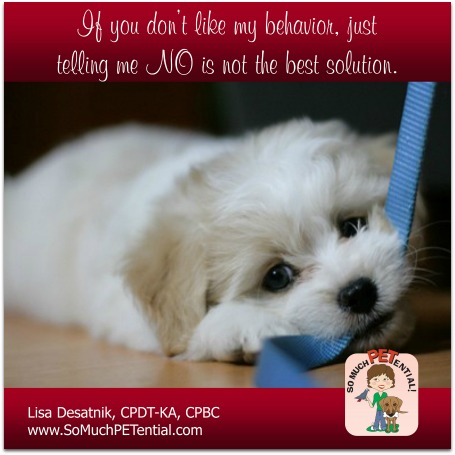I get asked a lot when I talk to people about focusing on what they want their pets to do, “But what do I do to tell my pet NO when he is doing something I don’t like?”
 Here is the thing about that question. First of all, while your dog may or may not momentarily stop what it is doing when you are saying NO, if you are needing to continue to use that word, then it is not solving your problem.
Here is the thing about that question. First of all, while your dog may or may not momentarily stop what it is doing when you are saying NO, if you are needing to continue to use that word, then it is not solving your problem.
There are many reasons why I do not like using that word. Those reasons include that while NO may stop the unwanted behavior in the moment, it does not give your pet any information on what you would like for him to do instead. Additionally, using aversives has the potential for creating apathy, fear, anxiety and even aggression – and you will become associated with those aversives. As the bad behavior police officer, you may also end of teaching your dog that it should not do the unwanted behavior in front of you. NO also doesn’t do much for fostering a love of learning.
Another thing to keep in mind is that constantly, living beings are making choices based upon where the value is for them. If the behavior serves to get the animal something of value (to the animal) – meaning the behavior is followed by something the animal values – then you will see more of that behavior. Researcher Edward Thorndike named that relationship between behavior and its consequences the Law of Effect; and it states that the strength of a behavior depends on its past effects on the environment. (Paul Chance: Learning & Behavior, fifth edition)
So, if the reinforcement for doing the behavior outweighs the negative of your punishment, your pet will continue to do the unwanted behavior…just possibly when you have got your back turned or are in another room.
You may also be following your word ‘NO’ with a redirection to a different behavior that has a history of reinforcement, and so you are inadvertently reinforcing the unwanted behavior.
Let’s also think about the teaching perspective from a human standpoint. Let’s say you are doing a task at work, and your boss reprimands you, simply telling NO, throughout the day. Does that feedback tell you what you need to do better to earn your boss’ praise? Over time with enough NOs, do you think your performance will continue to break down or will you be more motivated to succeed? I can tell you from first hand experience, I have both worked for people who have been on the look out to find faults and for people who have been on the look out to find strengths. For the first kind of supervisor, somehow, things continue to keep going wrong but in situations where I’ve worked for the later kind of supervisor, I have excelled.
So, what is a pet owner to do when a pet’s behavior is not acceptable?
First of all, step back from the situation for a moment, catch your breath and instead of blaming your pet for it simply doing what works in the moment to get its needs met, ask yourself what YOU can do differently to help your pet succeed.
Since, each practice of a behavior is highly likely to be building that behavior’s reinforcement history (and we know that behaviors that are reinforced are repeated), ask yourself what you can do to set up the environment so that your pet doesn’t have an opportunity to practice the unwanted behavior.
Think about what needs or wants that behavior helps your pet to meet, and behaviors you can teach (with a high rate of reinforcement) that will help your pet to get its needs and wants met in acceptable ways. Then teach those behaviors that will help your pet to succeed in your world. And remember, that while you are teaching those behaviors, to think about what management or arrangement of the environment should be in place to prevent the unwanted behavior from occurring.
And, have a plan for if that unwanted behavior should occur, how you will avoid giving value to that behavior.






